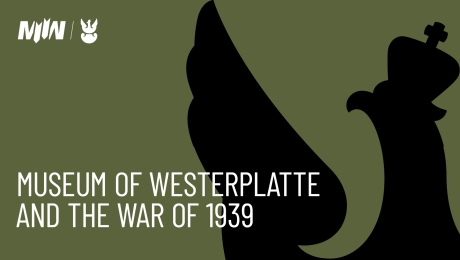The War Began in Gdańsk
The War Began in Gdańsk
From October to December 2009, an English-language exhibition “The War Began in Gdańsk” was shown in the Royal Museum of the Army and of Military History in Brussels in order to bring the Polish perspective on the Second World War to non-Poles.
The exhibition tells the story of the role of Gdańsk in the origins, beginning and course of the Second World War. Our exhibition demonstrates that Hitler’s occupation of Poland was much more brutal than the occupations of the countries of Western Europe. Its material, spiritual and cultural outcomes are visible to this day.
Gdańsk became a tinderbox in Polish-German relations, and Hitler’s demand that Gdańsk be incorporated into the Third Reich launched the largest and bloodiest armed conflict in the history of the world. Some of the first shots of the Second World War, those coming from the German battleship Schleswig-Holstein, were aimed at the Polish soldiers on the Westerplatte Peninsula in Gdańsk. Poland was the first country in the world to offer armed resistance to the Nazi invaders.
Multinational Gdańsk, which had been governed by Prussia since the partitions of Poland in 1772-1795, was declared a Free City and placed under the protection of a League of Nations High Commissioner by the Treaty of Versailles. Poland was granted special privileges there, which included the right to maintain its own military transshipment zone and a guard unit. The Military Transit Depot was created on Westerplatte Peninsula. Germany promoted the belief among the population of Gdańsk that the Treaty of Versailles had set unjust borders around the City. Nazi programme called for returning Gdańsk to the Reich. In 1938-1939, the Third Reich began its territorial expansion, annexing Austria, the Czech lands and Klaipeda. Poland was to be next, and the Reich demanded its consent to a German takeover of Gdańsk.
On Friday, 1 September 1939, at 4.47 the commander of the battleship Schleswig-Holstein gave the order to open fire at Westerplatte. A minute later, the first salvos fell. The Westerplatte garrison fulfilled its fundamental duty to defend the Depot in the first 12 hours of fighting. Its solitary defence of Westerplatte in the days that followed came to symbolise the heroism and courage of the Polish soldier. In the first days of the War, Polish Radio announcements that “Westerplatte continues to fight” upheld spirits across Poland. It was only on 7 September that the crew capitulated, realising that further resistance was hopeless. The Germans described the defence of Westerplatte as “the Polish Verdun”. As they accepted the surrender, the Germans were astounded when they found no system of underground fortifications, which, they thought, had made the Poles’ long defence of the Depot possible. To this day, Westerplatte exemplifies a battle against an overwhelming enemy, a battle of encirclement, a battle for honour.
Poland paid an enormous price for rejecting Hitler’s demands. From the very beginning of the Nazi and Soviet invasion of Poland, civilians and prisoners-of-war became victims of premeditated crimes. They included Poles living in Gdańsk before the War, who were exterminated in the nearby Stutthof concentration camp.
Following the Second World War it was here, in Polish Gdańsk, that opposition to the Soviet-imposed Communist system began to grow. The workers of the Gdańsk shipyard were at the heart of this opposition. Their August 1980 strikes and the birth in Gdańsk of the first trade union in a socialist country independent of Communist authorities, “Solidarity,” which was led by Lech Wałęsa were a watershed.











